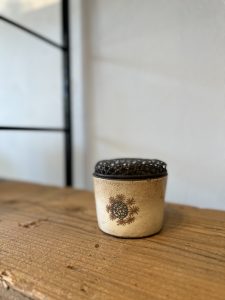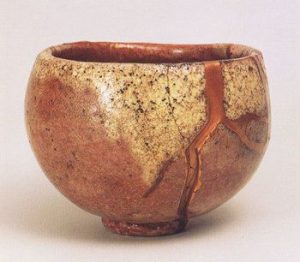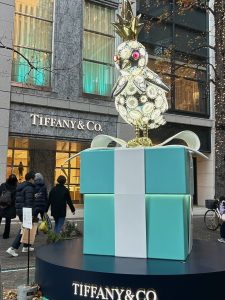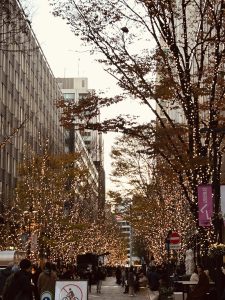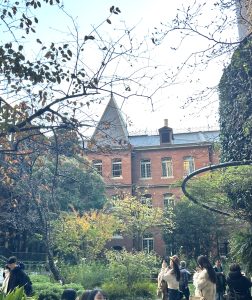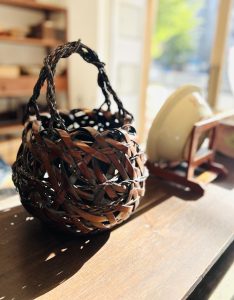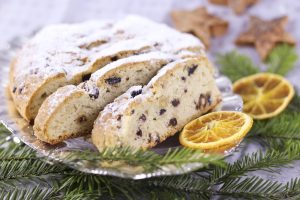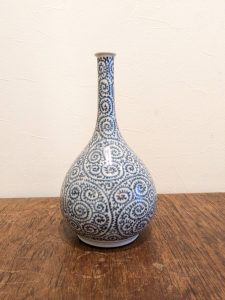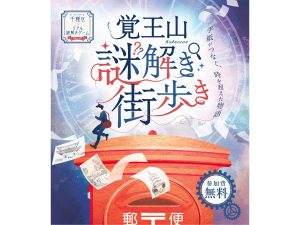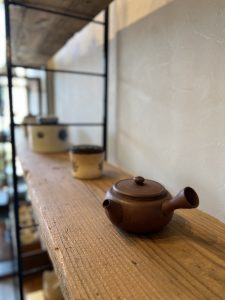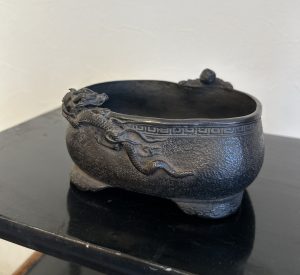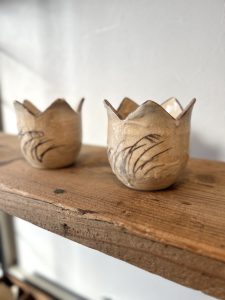つめ放題に燃える(愛知県名古屋市千種区姫池通 骨董買取 古美術風光舎)
2024.12.20
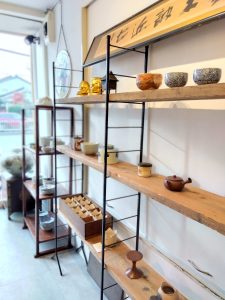
「詰め放題」。なぜかやっている人を見ると、ついついやりたくなってしまい、これ以上は無理だと分かっていても、どうにかねじ込みたくなるのは私だけでしょうか。
先日、友人に誘われ「ブラックサンダー」の楽園、愛知県豊橋市でブラックサンダー詰め放題をやってきました。
スーパーやコンビニで見かけるお菓子「ブラックサンダー」。実は工場併設の直営店で詰め放題が楽しめるのです。
子どもから大人まで多くの人に愛されている有楽製菓の「ブラックサンダー」は、1994年から販売を開始し、2024年に30周年を迎えました。今でこそ、年間販売個数2億個を突破する大ヒット商品ですが、発売当初は売り上げ不振が続き、一度は終売の危機にも瀕したそうです。
「ブラックサンダー」が愛知県豊橋市の工場で作られていることから、豊橋市内はブラックサンダー柄のマンホールがあったり、企業とのコラボでラッピング電車「ブラックサンダー号」が走っていたりします。ちなみに、マンホールは広小路通りにあり、うまくいけば「ブラックサンダー号」と一緒に写真が撮れるとか。
もしかしたらブラックサンダーをご存じない方もいるかもしれないので説明すると、ブラックサンダーとは、ココアクッキーとプレーンビスケットをチョコレートでコーティングしたお菓子のことですよ。
その知名度が全国区となったのは、2008年。北京五輪の直前に体操の内村航平選手が取材の中で「好きなお菓子はブラックサンダーです」と語ったのがきっかけでした。その翌年の販売数はなんと1億個を突破したのだそう。
有楽製菓豊橋夢工場直営店。ブラックサンダーファンには限定商品が購入できるのもたまらないですが、目玉は何といっても「ブラックサンダー詰め放題」。豊橋市に来たらこれですよ、皆さま!
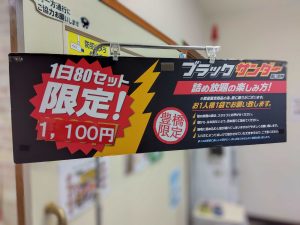
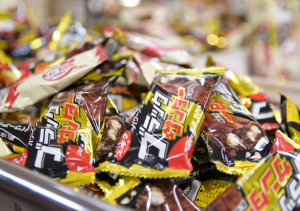
ルールはシンプルで、制限時間10分以内に渡される袋へ詰めるだけ。適当に重ねてしまうとたくさん入れることはできません。店員さんから詰め方のコツを教えていただいてからスタートです。
大胆に、それでいて優しくブラックサンダーを袋に詰めていきます。隙間を埋める様に縦に入れていきます。大量のブラックサンダーを目の前にテンションが上がり過ぎて無心でどんどん入れてしまいがちですが、焦りは禁物。土台となる下段に縦に隙間なく入れていくのがたくさん詰めるコツですよ。
制限時間は10分なので、丁寧に詰めていると時間が無くなってしまいます。ちなみに専用の袋は伸縮性がないので、無理に伸ばすと破れてしまうのでご注意を。袋からはみ出た分は残念ながら没収となります。
結果は47個!詰め放題は1000円で、ブラックサンダーの商品価格は1個40円。25個以上詰めれば元が取れる計算なので、かなり頑張りました(笑)
詰め放題の他にも、ブラックサンダーのロゴが入った防災用のヘルメットや歴代の商品パッケージがズラリと並ぶ大型パネル、社長のトリックアートがお出迎えなど、テンション爆上がりの楽しいひと時となりました。
ではでは、また。
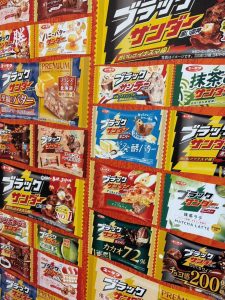
I’m not the only one who is tempted to do it when I see someone else doing it. For some reason, when I see someone doing it, I just want to do it, and even if I know I can’t go any further, am I the only one who wants to screw it up somehow?
The other day, a friend invited me to an all-you-can-eat Black Thunder stuffing event in Toyohashi, Aichi, the paradise of “Black Thunder.
Black Thunder” is a candy that can be found in supermarkets and convenience stores. In fact, you can enjoy all-you-can-stuffing Black Thunder at a store directly managed by the factory.
Black Thunder” by Yuraku Seika, loved by everyone from children to adults, has been on sale since 1994, and will celebrate its 30th anniversary in 2024. Today, the product is a big hit, selling more than 200 million units annually, but sales were sluggish when it was first launched, and at one point the company was on the verge of discontinuing the product.
Since Black Thunder is made at a factory in Toyohashi City, Aichi Prefecture, there are manholes in Toyohashi City with a Black Thunder pattern, and the “Black Thunder-go” train, a collaboration with a company, runs in the city. Incidentally, the manhole is located on Hirokoji Street, and hopefully you can take a picture with “Black Thunder-go”.
For those of you who may not know what Black Thunder is, it is a candy consisting of cocoa cookies and plain biscuits coated with chocolate.
It was in 2008 that it became nationally known. Just before the Beijing Olympics, gymnast Kohei Uchimura said in an interview, “My favorite candy is Black Thunder. The following year, sales exceeded 100 million units.
Yuraku Seika Toyohashi Dream Factory directly operated store. Black Thunder fans will love the limited-edition products available for purchase, but the highlight is the “all-you-can-stuff Black Thunder”.If you come to Toyohashi, this is the place to be, folks!
The rules are simple: you have only 10 minutes to fill the bags you are given. You can’t put in too many if they are stacked in the right order. The waiter gave me some tips on how to fill the bags before we started.
Boldly, yet gently, pack the Black Thunder into the bag. Fill the bag vertically so as to fill in the gaps. It is easy to get too excited with a large amount of Black Thunder in front of you and mindlessly put in more and more, but don’t be in a hurry. The trick is to fill the bottom layer, which is the base of the bag, vertically without gaps.
The time limit is 10 minutes, so if you pack carefully, you will run out of time. Note that the special bags are not elastic, so be careful not to stretch them too much or they will tear. Unfortunately, the portion of the bag that is overflowed will be confiscated.
The result was 47 pieces! The price for the all-you-can-stuff is 1,000 yen, and the price of each Black Thunder is 40 yen, so if you stuffed more than 25 pieces, you could get your money’s worth, so we worked pretty hard (laugh).
In addition to the all-you-can-stuff it, we were also greeted by an emergency helmet with the Black Thunder logo, a large panel of past product packages, and the president’s trick art.
See you soon.
*****************
ご実家の整理やお片付けなどをされている方のご相談などが多くございます。
お片付けなどくれぐれもご無理のないようになさってくださいませ。
風光舎では古美術品や骨董品の他にも絵画や宝石、趣味のお品など様々なジャンルのものを買受しております。
お片付けをされていて、こういうものでもいいのかしらと迷われているものでも、どうぞお気軽にご相談下さいませ。
また風光舎は、出張買取も強化しております。ご近所はもちろん、愛知県内、岐阜県、三重県その他の県へも出張いたします。
まずは、お電話お待ちしております。
愛知県名古屋市千種区姫池通
骨董 買取【古美術 風光舎 名古屋店】
TEL052(734)8444
10:00-18:00 OPEN
#出張買取#骨董#古美術#骨董品#絵画#版画#茶道具#刀剣#彫刻

